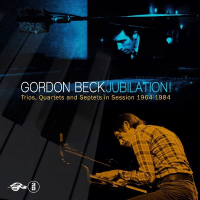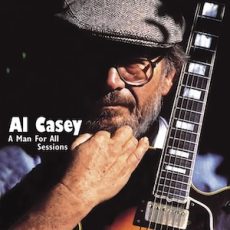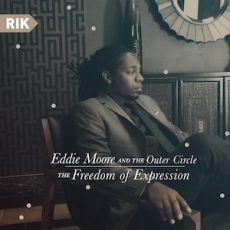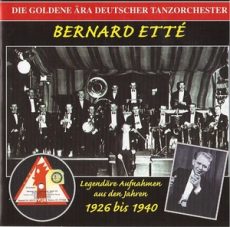
Daily Dose Of Jazz…
Joseph G. Cocuzzo was born on September 17, 1937 in Boston, Massachusetts and raised in a family of enthusiastic amateur musicians. He began playing drums as a small child, later studied extensively, and played in many bands in and around his home town.
In the late 1950s he was residing in Chicago, Illinois where he joined the big band led by Ralph Marterie before moving on to the Woody Herman band. By the early Sixties he worked with Don Ellis, Les and Larry Elgart, Gary McFarland and Tony Bennett. The mid-70s saw Joe returning to Bennett for a five-year engagement, then he was with Harry James before beginning a decade-long spell with Rosemary Clooney.
The subtle skills he displayed with Bennett and Clooney found him in demand as a singer’s accompanist and he also worked with Vic Damone, Julius LaRosa, Susannah McCorkle and Sylvia Syms. Throughout this period and on through the new millennium, Cocuzzo was in frequent demand for recording sessions, appearing on albums by many artists including Buddy De Franco and Dick Sudhalter.
During his time with Clooney Cocuzzo had begun writing song lyrics, and he went on to collaborate with several composers, notably the Brazilian Ivan Lins. A smooth and swinging player, always aware of the subtly supportive role required by many leaders, especially singers, Cocuzzo was a member of New York Swing.
Drummer and songwriter Joe Cocuzzo, who never recorded as a leader but has 77 recordings as a sideman, died on July 31, 2008 in New Jersey.
<!– wp:paragraph —More Posts: drums,history,instrumental,jazz,music,songwriter

Daily Dose Of Jazz…
Gordon James Beck was born on September 16, 1935 in Brixton, London, England where he attended Pinner County Grammar School. He studied piano in his youth, but decided to pursue a career as an engineering technical draughtsman and moved to Canada in 1957 for this reason.
Largely self-taught, he returned to music after returning home from Canada in 1958, where he had been exposed to the works of George Shearing and Dave Brubeck. He became a professional musician in 1960 and played with saxophonist Don Byas in Monte Carlo. Beck joined the Tubby Hayes group in 1962, then led his own bands from 1965, including Gyroscope, from 1968, a trio with bassist Jeff Clyne and drummer Tony Oxley.
1967 saw the Gordon Beck Quartet record the album Experiments with Pops released on Major Minor MMLP 21 in 1968. That same year they recorded with Joy Marshall and released as When Sunny Gets Blue decades later.
Beck first played with vocalist Helen Merrill in 1969 and continued the relationship into the 1990s when she toured Europe. From 1969 to 1972 he toured with saxophonist Phil Woods’s European Rhythm Machine.
In the Sixties and Seventies he was a house pianist at Ronnie Scott’s Jazz Club. Beck played experimental funk with George Gruntz from1973-75), and free jazz with improv drummer John Stevens and was a member of Nucleus between 1973 and 1974.
From middle age, Beck played predominantly in mainland Europe, recorded albums with Allan Holdsworth, Henri Texier, Didier Lockwood and others. He often played solo from the 1980s and started teaching music at the same poin and toured Japan with Holdsworth in 1985.
Pianist Gordon Beck stopped performing around 2005 because of poor health and died in Ely, Cambridgeshire, England on November 6, 2011.
More Posts: bandleader,history,instrumental,jazz,music,piano

Daily Dose Of Jazz…
Albert Aloysius Casey was born September 15, 1915 in Louisville, Kentucky. He was a child prodigy who first played violin, then switched to ukulele. He began playing guitar in 1930 and attended DeWitt Clinton High School in New York City where he studied guitar. He met Fats Waller in 1933 and the following year, at eighteen, he became a member of Waller’s band.
Making several recordings with the band, he is known for having played the solo in Buck Jumpin’. After Waller’s death in 1943, he led his own trio and for two consecutive years in the 1940s, he was voted best guitarist in Esquire magazine.
From 1957, he was a member of a rhythm and blues band led by King Curtis. Four years later he dropped out of music, though he returned in the 1970s to record with Helen Humes and Jay McShann. Another absence followed until 1981, when he returned to music to play with the Harlem Blues and Jazz Band.
During his career, Casey worked with Louis Armstrong, Chu Berry, Coleman Hawkins, Lionel Hampton, Billie Holiday, Billy Kyle, Frankie Newton, Clarence Profit, Art Tatum, and Teddy Wilson.
Guitarist Albert Casey died of colon cancer on September 11, 2005, four days shy of his 80th birthday.
More Posts: bandleader,guitar,history,instrumental,jazz,music

Daily Dose Of Jazz…
Eddie Moore was born in Houston, Texas on September 14, 1940 and began his musical journey at Texas Southern University where he earned a Bachelors in Arts and immersed himself in the Houston music scene. He relocated to Kansas City, studied under Bobby Watson at the University of Missouri-Kansas City and received a M.A in Jazz Studies.
He formed a jazz fusion group Eddie Moore & The Outer Circle in 2012, with diversity and inclusiveness defining him as an artist. His debut album, The Freedom of Expression, was released in 2013. With a performing and visual arts curator he created an experimental platform in partnership with Charlotte Street that pairs time-based artists, producers and musicians.
Eddie has received awards and a 2017 residency at the Kemper Museum of Contemporary Art. He has composed music that has been featured commercially for Sprint, Netflix’s Queer Eye, Morgan Cooper’s short film Room Tone, and Peacock’s Bel-Air.
He has shared the stage and recorded with Tia Fuller, Pam Watson, Logan Richardson, Maurice Brown, Boys II Men, Brian Blade and the Fellowship, John Baptiste, Erykah Badu, Mos Def, Bilal, Ledisi, Chantae Cann, Krystal Warren, Andre Hayward, Tivon Pennicott, and Various Blonde.
As an educator his passion for teaching sent him on a course as a jazz lecturer at the University of Kansas, created a pilot Incubator, Tribe Studios, which programs master classes, music business meet-ups, and provides creative/maker space for musicians and visual artists.
Pianist and bandleader Eddie Moore is an integral member of the music community in Kansas City, as well as an advocate for change and resources for professional artists.
More Posts: bandleader,educator,history,instrumental,jazz,music,piano

Daily Dose Of Jazz…
Bernard Etté was born on September 13, 1898 in Kassel, Germany. The son of a hairdresser, he studied music formally at the Louis Spohr Conservatory in Kassel. He initially worked with Carl Robrecht as an instrumentalist, playing piano and banjo in addition to violin.
In the early 1920s he assembled his own ensemble, and took up a residency in Berlin, Germany and performed on radio. The group also recorded in the 1920s, often with traveling American musicians. During the 1930s, as the Nazi party rose to power, Etté shifted away from jazz to light music, and led a large orchestra during World War II.
He played for wounded soldiers on behalf of the Nationalsozialistische Volkswohlfahrt in 1940 and for prison overseers at Auschwitz in 1944. After the war, he moved to the United States but was unsuccessful in adapting to new stylistic trends when he attempted a new career.
Returning to Germany, he led bands for luxury retreats in the East Frisian Islands and schlager and operetta backing bands in central Germany. By the end of the 1950s he quit actively playing music, and lived out his last years in an old folk’s home.
Bernard Etté, jazz and light music violinist and conductor died on September 26, 1973 in Mühldorf, Bavaria, Germany.
More Posts: bandleader,conductor,history,instrumental,jazz,music,violin


